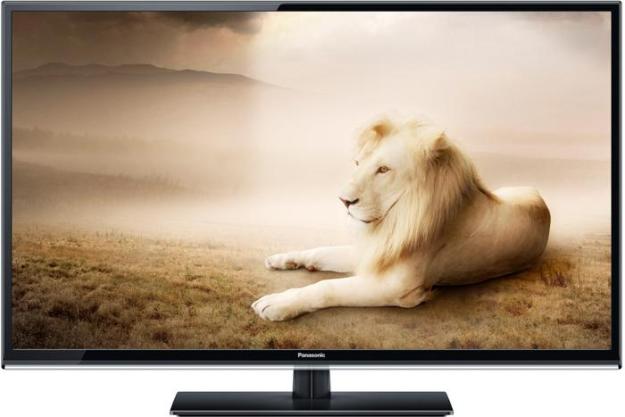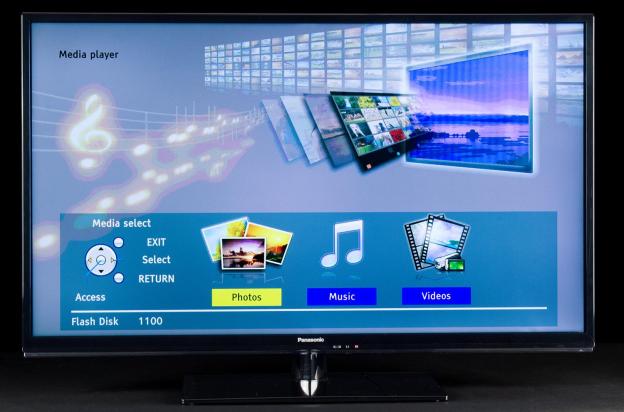
“With a slim feature set and a budget feel, we’d hoped to be knocked off our feet by the EM60’s picture quality. Unfortunately, that wasn’t the case.”
- Clean and sharp image
- Very little edge-light bleeding
- Thin frame
- Motion judder
- Inconsistent color
- Poor off-axis viewing
- Awkward menu
Panasonic EM60 Series information: This review is based on our hands-on experience with the 39-inch TC-L39EM60 TV. However, our observations also apply to the 50-inch TC-L50EM60. According to Panasonic, the two sets differ only in dimension and weight and offer identical features and performance.
|
Models in Panasonic EM60 series |
Size |
| Panasonic TC-L39EM60 (reviewed) | 39 inches |
| Panasonic TC-L50EM60 | 60 inches |
Panasonic is responsible for some of the most highly rated and popular plasma displays available. However, in recent years, the ballooning demand for cheaper and more durable LCD displays has forced plasma-focused companies to redouble their efforts in the segment, just to keep up. With that in mind, we decided to check out one of Panasonic’s lower-tier LCD models, the TC-L39EM60 (EM60), to see how it stacks up against the competition. The $500 EM60 hits all the right notes, with a 39-inch screen (a 50-inch model is also available), 1080p resolution, and a 120Hz native refresh rate. But specs aside, we wondered if it had the chops to put up a good fight in one of the most competitive segments in electronics. After spending some quality time with the EM60, here’s what we discovered.
Out of the box
Pulling the EM60 from its box revealed a surprisingly thin frame, with the same slim bezel and black gloss exterior that has become so ubiquitous in the entry level LCD set. The front face was pretty hum-drum, with no real standout features, save a small Plexiglas strip lining the bottom edge. Frankly, the design is a bit boring, and at 24 lbs., it’s also on the heavy side for today’s über-light panels. With that said, the TV’s 2.6-inch depth makes it one of the slimmest backlit LCD displays in its price range, and it looks sharp enough mounted on its stand.
Features and design
While we understand the EM60 is relegated to the budget aisle of Panasonic’s vast flat screen collection, we were slightly disappointed with the TV’s exterior composition. As we got hands-on with the display during our initial set-up, the plastic frame felt a bit thin and fragile, especially at the back panel, which bent an alarming amount at the center on contact.

The TV’s main bank of ports is recessed about a half-inch on the back right side. The medial selection includes two HDMI inputs, a single Component input (with no hybrid Composite connection), a Coaxial cable input, and a lone audio output in the form of a digital optical port. Examining the adjacent side bay revealed a faux-input bordered with plastic where we assume a 3rd HDMI input is available at the next price point. Unfortunately, our model harbored only a USB media input at the side.
The remote control is predictably succinct, with a small collection of keys layered across its light plastic frame. Notable additions include a quick key for accessing the USB media port, as well as those for a sleep timer and a favorite channels menu. Other than that, the remote is utility at its most basic, with large buttons and plenty of open real estate along the front face. Onboard control of the TV is accomplished via a collection of buttons tucked behind the right edge of the panel.
As for the man behind the curtain, so to speak, the EM60 has a respectable collection of digital weaponry, including a three-level frame interpolation feature called Motion Picture Setting, and a 3:2 pulldown assistant to help cleanup 24fps content. There’s also two noise reduction features to smooth out digital content and a Black level setting that adjusts between Dark and Light, intended to improve the depth of blacks and, therefore, contrast.
Setup
Dialing in the EM60’s picture settings was mostly straightforward, with the exception of one particularly vexing design quirk that drove us crazy. The very first heading under the picture settings menu is the “Reset to defaults” option, which erases all of your personalized settings without warning: no “are you sure” prompt, no passing “GO”, just straight to picture settings jail. To make things even more frustrating, the setting is activated by simply moving the navigation key to the right one step too far – an easy mistake to make since that’s the only way to get into the picture menu.

Aside from that, we didn’t have much trouble dialing things in, save the color, which was difficult to get looking natural. The TV offers 5 basic picture presets, including Game, Vivid, Cinema, Standard, and Custom. We observed early on that the Cinema preset was drastically different from the rest of the pack, with the backlight setting moved all the way down to 25 (on a scale of 100. Standard starts at 80). As such, we made our adjustments from the Standard preset, with moderate fixes to all basic picture settings, aside from the Sharpness option. A full list of our preferred settings is available at the end of this review.
Performance
The EM60 produced sharp and vivid images with brilliant colors. Nature scenes at 1080p were gorgeously rendered, with crystal clear edges. However, the limited nature of the TV’s LCD panel was made excruciatingly apparent due to a significant amount of color loss when the set was viewed off-axis. Standing just to the side or even standing up significantly diminished the image quality. The TV also showed a strong affinity for the color green, which always looked subjectively more vivid than the rest of the palette. Our attempts to balance the spectrum with the Tint setting only created uneven flesh tones. The oddest by-product of the issue came from select low-resolution content, especially with black and white images, in which we saw a green hue around the edges that was a little reminiscent of the movie The Matrix.
Standing just to the side or even standing up significantly diminished the image quality.
The EM60 also had a penchant for judder, especially when rendering fast-action sports, but we were able to tamper the issue relatively effectively by setting the Motion Picture feature to “weak” or “medium.” However, watching other media with the feature active created some of the wackiest fast-action motion we’ve come across. As such, we had to switch between the active and inactive modes fairly regularly, performing several inadvertent factory resets of the picture settings along the way. Grrrr.
While judder during HDMI and broadcast TV content was nominal for most of our viewing, the motion issues we encountered while streaming media through the TV’s Component input were more troubling. Though some content was unaffected, programming with swift camera movements and long pans like The Hunger Games, or The Office revealed instances of a halting, almost earthquake-like shudder. There was also a sluggish lag during gaming, making the Component input virtually unusable for it. We realize that analog inputs are on their way out, but such a lapse in performance was still disappointing.

The brightest spot of the EM60’s performance for us was actually the absence of them. The bright flares that guard the corners and edges of most entry-level LCD TVs during dark sequences were scarce on the EM60; resulting in the least amount of edge-light bleed we’ve come across in this class of television. Shadow detail was also well revealed with the Black Level adjustment set to “Light”, though the trade-off was a less-inky panel than we prefer.
Audio performance
Like most of the thinner LCD displays we review, the EM60 had pretty weak onboard sound. The treble was thin and flat, and even when we turned the setting down several notches, audio was a bit too sharp for our taste.
Conclusion
With a fairly slim feature set and a budget feel to the overall design, we’d hoped to be knocked off our feet by the EM60’s picture quality. Unfortunately, that wasn’t the case. Judder issues, inconsistent color, and poor sound gave a lackluster impression of Panasonic’s working-class model. We think thrifty consumers will be more satisfied with the LG LN5300 or the Vizio E-420i-AO because, while the EM60 has its moments, this fierce market demands better.
Highs
- Clean and sharp image
- Very little edge-light bleeding
- Thin frame
Lows
- Motion judder
- Inconsistent color
- Poor off-axis viewing
- Awkward menu
|
Digital Trends Picture Settings |
|
The following settings were arrived at through a process of manual adjustment and further adjusted for preference. As indicated in our How we test televisions article, processing such as noise reduction and dynamic contrast are disabled for picture and testing purposes. They may or may not be re-engaged based on subjective preferences gained from observation during real-world performance scenarios. Though we arrived at these settings with a specific TV size, these settings can be used for any of the sizes in this TV series with consistent results. |
|
Preferred Settings Backlight – 65 Contrast – 85 Bright – 48 Color – 51 Tint – (-10) Sharpness – 50 Color temp. – Warm A.I. picture – off Video NR – Weak Advanced Picture 3D Y/C filter – greyed out Color matrix – greyed out MPEG NR – On 3:2 pulldown – Auto Aspect Adjustment Screen format – FULL H size – Size 1 (broadcast TV), Size 2 (HDMI) Zoom adjustments – greyed out |




